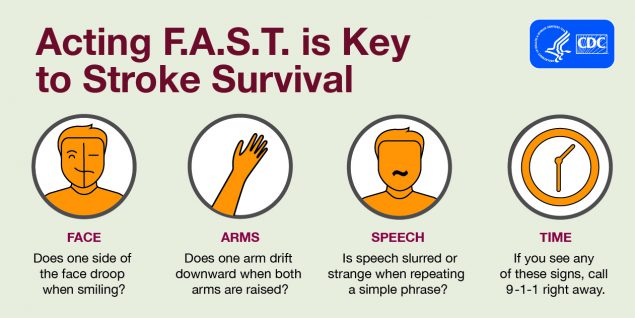Hypertension and Stroke (women)
Stroke is the fifth leading cause of death for women. In the United States, 1 in 5 women between the ages of 55 and 75 will have a stroke.
Surprised? You’re not alone. Many women do not know their risk of having a stroke.
These facts are alarming, but there is good news: 4 in 5 strokes are preventable. That’s why it’s important to know your risk for stroke and take action to protect your health.

Acting F.A.S.T. is key to stroke survival. Face: Does one side of the face droop when smiling? Arms: Does one arm drift downward when both arms are raised? Speech: Is speech slurred or strange when repeating a simple phrase? Time: If you see any of these signs, call 9-1-1 immediately.
What is a stroke?
A stroke, sometimes called a brain attack, happens when blood flow to an area of the brain is blocked or when a blood vessel in the brain bursts. Blood carries oxygen to cells in the body. When brain cells are starved of blood, they die.
Stroke is a medical emergency. It’s important to act F.A.S.T. and get treatment as soon as possible
Some treatments for stroke work only if given within the first 3 hours after symptoms start. A delay in treatment increases the risk of permanent brain damage or death.
What puts women at risk for stroke?
High blood pressure, also called hypertension, is a main risk factor for stroke.
More than 2 in 5 women have blood pressure greater than or equal to 130/80 mm Hg or are taking medicine to control their blood pressure. Only about 1 in 4 of those women have their blood pressure controlled to below 130/80 mm Hg.
Stroke risk increases with age. Because women generally live longer than men, more women have strokes over their lifetimes.
Women also have unique risk factors for stroke, including:
- Having high blood pressure during pregnancy.
- Using certain types of birth control medicines, especially if they also smoke. About 1 in 9 women smoke.
- Having higher rates of depression.
Why are African American women at higher risk for stroke?
Stroke is a leading cause of death among African American women, who are more likely to die from a stroke than non-Hispanic White women or Hispanic women in the United States. African Americans have the highest rate of death due to stroke among all racial and ethnic groups.
- Almost 3 in 5 African American women are diagnosed with high blood pressure (greater than or equal to 130/80 mm Hg), which is a much higher proportion than White women (almost 2 in 5).
- African American women are diagnosed with higher rates of obesity (nearly 3 in 5) and diabetes (more than 1 in 8), conditions that increase the risk for stroke, than White women.
- U.S. adults, including African Americans, consume more than the recommended amounts of salt or sodium, which raises blood pressure and increases the risk for stroke.
- Sickle cell disease, a common genetic disorder in African Americans, can lead to a stroke. About 1 in 365 African American babies are born with sickle cell disease.
- Smoking greatly increases stroke risk. About 1 in 8 African American women smoke.
Why are Hispanic women at risk for stroke?
Stroke is the fourth leading cause of death for Hispanic women.
- High blood pressure is one of the main risk factors for a stroke. More than 1 in 3 Hispanic women have blood pressure above 130/90 mm Hg.
- People with diabetes are at higher risk for stroke. More than 1 in 9 Hispanic women have diabetes—including many who don’t know they have the disease. Among adults of Hispanic origin, diabetes is most common in people of Mexican and Puerto Rican ancestry.
- Obesity increases the risk for stroke. About half of Hispanic women have obesity.
How can I prevent stroke?
Most strokes can be prevented by keeping medical conditions under control and making healthy lifestyle changes:
Know your ABCS of heart and brain health:
- Aspirin: Aspirin may help reduce your risk for stroke by preventing blood clots, but you should check with your doctor before taking aspirin to make sure it is right for you.
- Blood pressure: Control your blood pressure with healthy lifestyle changes (see below) and take your blood pressure medicines as directed. Learn more about blood pressure.
- Cholesterol: Manage your cholesterol with healthy lifestyle changes and take your medicine as directed. Learn more about cholesterol.
- Smoking: Don’t start smoking. If you do smoke, learn how to quit.
Make lifestyle changes
- Eat healthy: Choose healthy foods, including foods with less salt, or sodium, to lower your blood pressure and foods that are rich in fiber and whole grains to manage your cholesterol.
- Get regular physical activity: Regular physical activity helps you reach and maintain a healthy weight and keeps your heart and blood vessels healthier. Adults age 18 and older should get at least 150 minutes (2 hours and 30 minutes) of physical activity each week and do muscle strengthening activities on 2 or more days each week.
Work with your health care team
- Talk to your doctor about your chances of having a stroke, including your age and whether anyone in your family has had a stroke.
- Get other health conditions under control, such as diabetes or heart disease.